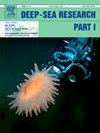Early signs of recovery suggested by changes in the structure and function of deep-sea megabenthic communities on a seamount 19 years after fishing
IF 2.1
3区 地球科学
Q2 OCEANOGRAPHY
Deep-Sea Research Part I-Oceanographic Research Papers
Pub Date : 2025-04-01
DOI:10.1016/j.dsr.2025.104488
引用次数: 0
Abstract
Bottom trawling is the most widespread and severe human disturbance affecting deep-seafloor environments. Seafloor communities inhabiting seamounts (undersea hills or mountains) are especially vulnerable to trawling impacts as they are often dominated by long-lived, sessile epifauna (e.g., cold-water corals) that are easily damaged and/or removed by fishing gear. Trawling on seamounts is spatially concentrated, compounding effects on the benthos. However, the extent to which communities on seamounts that are closed to fishing can recover from earlier trawling impacts is uncertain. Previous studies have hypothesised that any post-trawling recovery of benthic communities on seamounts will probably be initially patchy, recolonised by surviving remnant populations, and may take several decades or more to occur. A fine-scale approach is thus needed to understand and determine the spatio-temporal dynamics of recovery. To address this need, we studied a New Zealand seamount located on Chatham Rise, Morgue, that was heavily trawled in the 1990s before being closed to fishing in 2001. We analysed seafloor imagery collected with a towed camera during repeat surveys in 2001, 2005, 2009, 2015, and 2020 to examine potential changes in benthic community structure and function after trawling ceased. A temporal shift in community structure driven by changes in the abundances of several taxa (mainly bryozoans, stylasterid hydrocorals, and comatulid crinoids) was observed over the study timescale, indicating the communities may have been in the early stages of post-trawling recovery. However, structural variation between different seamount sides and the summit (i.e., spatial variation) was still more pronounced than temporal variation and reflected the trawl fishing footprint. Community function showed little sign of ongoing recovery overall, though some change (driven by colonisation by stylasterid hydrocorals and bryozoans) indicative of early recovery was observed for communities on the seamount summit. Juvenile colonies of the reef-forming stony coral Solenosmilia variabilis were also observed between 8 and 19 years after the closure, demonstrating that the fisheries closure may have facilitated the early recovery process of this species and its associates. Overall, this work has important implications for the spatial management of seamounts vulnerable to bottom-contact fishing operations.
在捕鱼19年后,海底山的深海巨型生物群落的结构和功能发生了变化,这表明了恢复的早期迹象
海底拖网捕捞是影响深海环境的最广泛和最严重的人为干扰。居住在海山(海底丘陵或山脉)的海底群落特别容易受到拖网捕捞的影响,因为它们通常由寿命长、不固定的表层动物(例如冷水珊瑚)主导,容易被渔具破坏和/或移走。海底山拖网捕捞在空间上是集中的,对底栖生物的影响是复合的。然而,不允许捕鱼的海山社区能在多大程度上从早期拖网捕鱼的影响中恢复过来还不确定。先前的研究假设,海底山底栖生物群落在拖网捕捞后的任何恢复,最初都可能是不完整的,由幸存的残余种群重新定居,可能需要几十年或更长时间才能发生。因此,需要一种精细尺度的方法来理解和确定恢复的时空动态。为了满足这一需求,我们研究了位于莫格尔查塔姆高地的新西兰海山,该海山在20世纪90年代被大量拖网捕捞,直到2001年禁止捕鱼。我们分析了2001年、2005年、2009年、2015年和2020年重复调查期间用拖网相机收集的海底图像,以研究拖网捕捞停止后底栖生物群落结构和功能的潜在变化。在研究时间尺度上,观察到由几种分类群(主要是苔藓虫、花柱状水珊瑚和菊石)的丰度变化驱动的群落结构的时间变化,表明群落可能处于拖网捕捞后恢复的早期阶段。但海山两侧和山顶之间的结构变化(即空间变化)仍比时间变化更为明显,反映了拖网捕捞足迹。总体而言,群落功能没有显示出持续恢复的迹象,尽管在海山山顶的群落中观察到一些变化(由针状类水珊瑚和苔藓虫的定殖驱动)表明早期恢复。在渔场关闭后的8至19年间,还观察到形成珊瑚礁的石珊瑚变螺杆石珊瑚(Solenosmilia variabilis)的幼群,这表明渔场关闭可能促进了该物种及其同伴的早期恢复过程。总的来说,这项工作对易受海底接触捕鱼作业影响的海底山的空间管理具有重要意义。
本文章由计算机程序翻译,如有差异,请以英文原文为准。
求助全文
约1分钟内获得全文
求助全文
来源期刊
CiteScore
4.60
自引率
4.20%
发文量
144
审稿时长
18.3 weeks
期刊介绍:
Deep-Sea Research Part I: Oceanographic Research Papers is devoted to the publication of the results of original scientific research, including theoretical work of evident oceanographic applicability; and the solution of instrumental or methodological problems with evidence of successful use. The journal is distinguished by its interdisciplinary nature and its breadth, covering the geological, physical, chemical and biological aspects of the ocean and its boundaries with the sea floor and the atmosphere. In addition to regular "Research Papers" and "Instruments and Methods" papers, briefer communications may be published as "Notes". Supplemental matter, such as extensive data tables or graphs and multimedia content, may be published as electronic appendices.

 求助内容:
求助内容: 应助结果提醒方式:
应助结果提醒方式:


